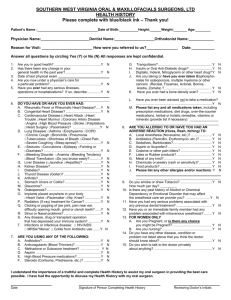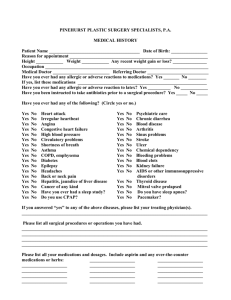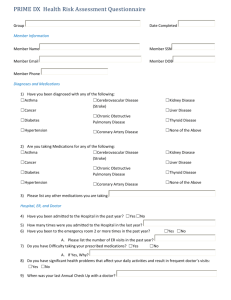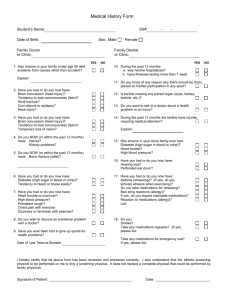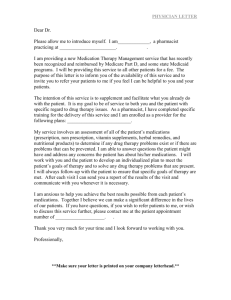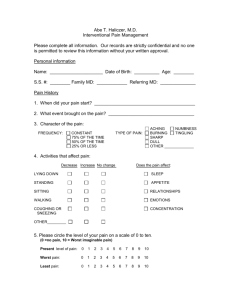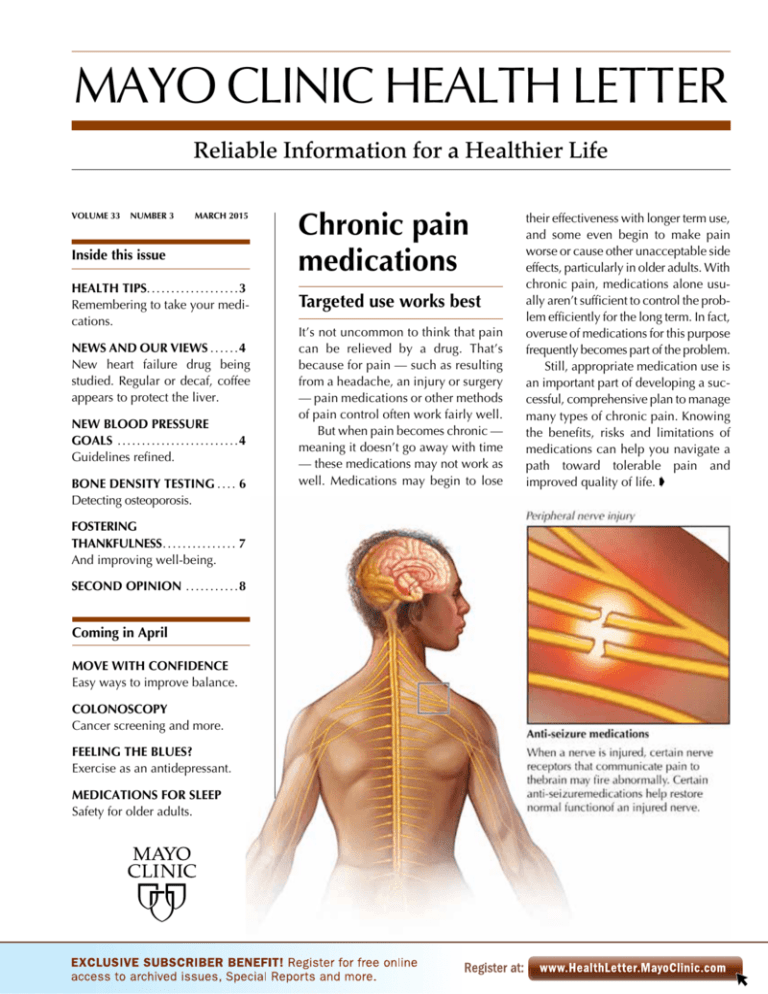
MAYO CLINIC HEALTH LETTER
Reliable Information for a Healthier Life
VOLUME 33
NUMBER 3
MARCH 2015
Inside this issue
HEALTH TIPS . . . . . . . . . . . . . . . . . . 3
Remembering to take your medications.
NEWS AND OUR VIEWS . . . . . . 4
New heart failure drug being
studied. Regular or decaf, coffee
appears to protect the liver.
NEW BLOOD PRESSURE
GOALS . . . . . . . . . . . . . . . . . . . . . . . . 4
Guidelines refined.
BONE DENSITY TESTING . . . . . 6
Detecting osteoporosis.
FOSTERING
THANKFULNESS . . . . . . . . . . . . . . . 7
And improving well-being.
SECOND OPINION . . . . . . . . . . . 8
Coming in April
MOVE WITH CONFIDENCE
Easy ways to improve balance.
COLONOSCOPY
Cancer screening and more.
FEELING THE BLUES?
Exercise as an antidepressant.
MEDICATIONS FOR SLEEP
Safety for older adults.
Chronic pain
medications
Targeted use works best
It’s not uncommon to think that pain
can be relieved by a drug. That’s
­because for pain — such as resulting
from a headache, an injury or surgery
— pain medications or other methods
of pain control often work fairly well.
But when pain becomes chronic —
meaning it doesn’t go away with time
— these medications may not work as
well. Medications may begin to lose
their effectiveness with longer term use,
and some even begin to make pain
worse or cause other unacceptable side
effects, particularly in older adults. With
chronic pain, medications alone usually aren’t sufficient to control the problem efficiently for the long term. In fact,
overuse of medications for this purpose
frequently becomes part of the problem.
Still, appropriate medication use is
an important part of developing a successful, comprehensive plan to manage
many types of chronic pain. Knowing
the benefits, risks and limitations of
medications can help you navigate a
path toward tolerable pain and
­improved quality of life. ➧
Targeted options
Deciding on potential drug therapy
for your chronic pain usually involves
an analysis of the cause or causes of
pain and knowing which type of drug
may be beneficial. Potential side effects
of drug options also are part of the
analysis, as is the question of how a
drug fits into your overall plan to
­address chronic pain or with treatment
plans for other problems.
Antidepressant drugs are commonly
used for multiple types of chronic pain
problems — such as fibromyalgia, low
back pain, headaches, diabetic neuropathy and other forms of nerve pain.
In some people, antidepressants appear
to help with pain, independent of their
possible effect on depression. They can
also improve depression symptoms —
which can be caused by chronic, unrelieved pain. Some antidepressantss may
also help promote sleep and reduce
anxiety — all of which may contribute
to pain. Antidepressants usually don’t
lose their effect due to the development
of tolerance, and they may increase the
effect of other pain drugs.
Tricyclic antidepressant drugs — including amitriptyline, desipramine
(Norpramin) and nortriptyline (Pamelor)
— are well-studied and a­ ppear to be
effective for many types of chronic pain.
However, side effects such as drowsiness, dry mouth, blurred vision and
constipation can be a problem, particularly in older adults. Serotonin and norepinephrine reuptake inhibitor (SNRI)
antidepressant drugs — such as duloxetine (Cymbalta), venlafaxine, or milnacipran (Savella) — have several Food
and Drug Administration-approved uses
for chronic pain and generally cause
fewer side effects than do tricyclic antidepressants.
Several drugs developed primarily
to control epileptic seizures have been
found to help the chronic stabbing or
shooting pain that can result from nerve
damage or impaired communication in
the central nervous system. When a
nerve is injured or functioning abnormally, certain nerve receptors that com-
2
municate pain to the brain may fire
inappropriately. Anti-seizure medications can help reduce this activity and
decrease pain levels.
These drugs — which include
gabapentin (Neurontin), pregabalin
­
(Lyrica), carbamazepine (Carbatrol,
Tegretol) and others — may be used to
dampen pain of diabetic neuropathy or
fibromyalgia, pain following shingles
(postherpetic neuralgia) or facial pain
due to trigeminal neuralgia. Drowsiness, dizziness and weight gain are
among the more common side effects
of these drugs.
With many pain drugs, it’s often
best to start at a low dose to minimize
side effects, and to increase the dose
gradually to an effective target dose. A
period of up to six months may be
­recommended in order to evaluate the
benefits and side effects along the way.
Dangers of opioids
Pain medications can end up
­contributing to a destructive cycle of
worsening chronic pain. One common
offender is a class of drugs called
­opioids, which are commonly referred
to as narcotics. Opioid medications
include morphine, ­codeine, hydromorphone (Dilaudid), oxycodone (Oxycontin, Roxicodone), tramadol (Ultram)
and others.
Opioid drugs can be highly effective for relief of acute pain lasting less
than about four months, and can play
a crucial role in relief of cancer pain,
particularly in relieving end-of-life suffering. However, a large body of
­research has shown that ongoing opioid therapy is of limited benefit for
chronic pain. In addition to risks of drug
­dependence and addiction, continuous
use of opioids may result in:
■ Side effects such as dizziness, drowsiness, sedation and unclear thinking
which are especially prevalent in older
people and may get worse with higher
doses. Many of these side effects go
away with steady dosing over a period
of time. Other side effects include constipation and hormonal disturbances.
www.HealthLetter.MayoClinic.com March 2015
■
The development of tolerance, in
which higher doses of a drug are needed to get the same pain-relieving effect.
■ Changes in your central nervous
system that may heighten your perception of pain.
■ Rebound pain, in which pain recurs
after a dose wears off.
Chronic use of opioid drugs — particularly at low doses — can sometimes
play a role in chronic pain management
if strategically prescribed by your doctor
and monitored very carefully. Strong
consideration needs to be given to the
risk versus benefit of chronic opioid
medication, and ongoing use needs to
be continually assessed for achievement
of pain relief and functioning goals.
Nonmedication strategies
Using drugs to manage chronic
pain works best as part of a larger plan
that may include regular exercise and
MAYO CLINIC HEALTH LETTER
Managing Editor
Aleta Capelle
Medical Editor
Robert Sheeler, M.D.
Associate Editors
Rachel Bartony
Joey Keillor
Associate Medical Editor
Amindra Arora, M.B.,
B.Chir.
Medical Illustration
Michael King
Editorial Research
Deirdre Herman
Operations Manager
Christie Herman
Copy Editing
Miranda Attlesey
Alison Baker
Julie Maas
Administrative Assistant
Beverly Steele
EDITORIAL BOARD
Shreyasee Amin, M.D., Rheumatology; Amindra
Arora, M.B., B.Chir., Gastroenterology and Hepatology;
Brent Bauer, M.D., Internal Medicine; Julie Bjoraker,
M.D., Internal Medicine; Lisa Buss Preszler, Pharm.D.,
Pharmacy; Bart Clarke, M.D., Endocrinology and
Metabolism; William Cliby, M.D., Gynecologic
Surgery; Clayton Cowl, M.D., Pulmonary and Critical
Care; Mark Davis, M.D., Derma­tology; Timothy
Moynihan, M.D., Oncology; Daniel Roberts, M.D.,
Hospital Internal Medicine; Robert Sheeler, M.D.,
Family Medicine; Phillip Sheridan, D.D.S.,
Perio­don­tics; Peter Southorn, M.D., Anes­thesiology;
Farris Timimi, M.D., Cardiology; Matthew Tollefson,
M.D., Urology; Debra Zillmer, M.D., Orthopedics;
Aleta Capelle, Health Information. Ex officio: Joey
Keillor.
Mayo Clinic Health Letter (ISSN 0741-6245) is
published monthly by Mayo Foundation for Medical
Education and Research, a subsidiary of Mayo
Foundation, 200 First St. SW, Rochester, MN 55905.
Subscription price is $31.52 a year, which includes a
cumulative index published in January. Periodicals
postage paid at Rochester, Minn., and at additional
mailing offices. POSTMASTER: Send address changes
to Mayo Clinic Health Letter, Subscription Services,
P.O. Box 9302, Big Sandy, TX 75755-9302.
Health tips
Remembering to take
your medications
activity, physical therapy, counseling,
stress management, acupuncture, massage therapy and other components.
Some people may be able to find
adequate pain relief by working with
their primary care doctor. However,
visiting a more comprehensive pain
rehabilitation center may be worth considering if you and your doctor have
struggled to find effective management
for your pain. Reducing or eliminating
unhelpful medications — often with a
planned tapering of the drug — is a
common occurrence in pain rehabilitation programs.
For your part, it’s important to know
the purpose of any drug you’re taking.
Have in writing the plan for dosing and
stick to the plan. In addition, keep track
of how the drug is working. If it doesn’t
seem beneficial or side effects occur,
talk to your doctor about adjustments.
Drug effects or side effects may
change over time, especially as other
drugs are added or stopped and if new
medical conditions arise. ❒
Polypharmacy
Many with chronic pain end up taking multiple pain medications (polypharmacy) that have been prescribed over time by various health care providers.
Your providers might not be aware of medications prescribed by others. The
result is an increased risk of side effects from drug interactions from multiple
pain medications, medications taken for other problems, nonprescription
medications or even alcohol. Moreover, the increased risks don’t necessarily come with improved pain control, and the expense of taking multiple
medications can be substantial.
Although any drug could contribute to harmful polypharmacy, common
pain-related drugs that may do so include muscle relaxants, drugs for sleep
and drugs for anxiety. These are sometimes prescribed to help with dealing
with pain and are typically intended for short-term use of a couple of days
or weeks. However, instructions for proper duration of drug use can get lost
in the shuffle, leading to ongoing therapy that doesn’t help and may cause
side effects and dependence.
If you’re taking multiple pain medications, sit down with your doctor, a
chronic pain specialist or a pharmacist for a focused review of all your
medications. You and your doctor may need to refocus on the root cause of
your pain and take a critical look at the benefits of each drug you’re taking.
March 2015
Prescribed medications don’t
work if you forget to — or simply
don’t — take them. Improve your
ability to take medications by:
■ Making it easy — Work with
your doctor and pharmacist to
keep your drug regimen to the
fewest pills possible. Ask your
pharmacist for easy-open lids if
opening pill bottles is a problem.
A variety of pillboxes are available
to help keep your medications
organized. Ask for clear instructions on when to take your drugs.
■ Being motivated — Understand what you are taking and
why. It’s harder to stay motivated
to take a medication when you
don’t know why you’re taking it.
■ Using reminders — Ask your
pharmacist about the wide range
of reminder technology options
available. Among them are bottle
caps that glow or make noise
when you need to take a pill,
wristwatches or alarm clocks with
pill reminders, systems that send
text messages or email reminders,
and apps for a smartphone.
■ Tackling side effects — ­Rather
than just stopping the drug if you
experience side effects, contact
your doctor to ask about adjusting dose, switching to another
medication or taking other steps
to diminish the side effects.
■ Addressing cost — Ask your
pharmacist if there’s a more
affordable option for the drug
­
prescribed. This may be as simple
as switching from a newer brand
name to a generic drug. Or, there
may be a way to alter your overall
therapy plan to a lower cost
­option that’s similarly effective. ❒
www.HealthLetter.MayoClinic.com
3
News and our views
New heart failure drug being studied
People with heart failure may soon have another — perhaps more effective
— alternative to the drugs currently available to treat the condition.
A recent study involving a large group of people with heart failure found
that the investigational drug LCZ696 performed better than the angiotensinconverting enzyme (ACE) inhibitor enalapril (Vasotec), a drug that’s considered to be a first-line therapy for heart failure. LCZ696 is a combination of
two drugs — sacubitril, an experimental compound that works to inhibit the
actions of an enzyme called neprilysin, and valsartan (Diovan), an angiotensin II receptor blocker (ARB) that works similarly to ACE inhibitors to
dilate blood vessels and improve blood flow.
The group taking LCZ696 experienced fewer deaths and hospitalizations
due to cardiovascular causes, as well as fewer overall deaths, when compared with the group taking enalapril. Because of the advantages of LCZ696,
the trial was ended early so that both groups could benefit from the new
drug. Importantly, LCZ696 also didn’t cause the swelling that’s occasionally seen with ACE inhibitors.
Results of the trial suggest that LCZ696, if approved for prescription in the
U.S., may replace ACE and ARB inhibitors as first line therapy for heart failure.
Mayo Clinic doctors, along with others, welcome new and improved ways
to treat heart failure. However, as with any new drug, they advise caution,
and hope the safety of LCZ696 is confirmed by continued research. ❒
Regular or decaf, coffee appears to protect the liver
Research supporting an association between coffee drinking and good health
has been gaining momentum. Coffee is now associated with health benefits
in many areas such as reducing the risk of cardiovascular disease and diabetes, maintaining a healthy weight, and longevity.
The benefits appear to be especially robust in terms of liver health. Coffee appears to reduce the risk of developing fibrosis or cirrhosis of the liver,
and has been associated with a 40 to 50 percent reduction in the risk of
developing the most common type of liver cancer. Most recently, a Mayo
Clinic-led study found an association between coffee drinking and reduced
risk of the liver autoimmune disease called primary sclerosing cholangitis.
A review of multiple studies looked at differences in the health benefits
of regular coffee and decaffeinated coffee. The idea was to learn whether
it’s the caffeine in coffee that leads to health benefits or some other factor
such as antioxidant compounds, of which coffee is a rich source. The study
found that people who drank about two to three cups of coffee a day had
the lowest odds of having abnormal liver test measurements, compared with
people who drank less. People who drank decaf and those who drank caffeinated coffee appeared to have similar benefits, although there were too
few decaf drinkers in the studies to make a definitive conclusion.
There’s no need to feel guilty about enjoying your coffee. Keeping your
daily consumption of caffeine at a moderate level of about 200 to 300 milligrams a day — which is two to three cups of regular brewed coffee — is a
safe level for healthy adults. If caffeine isn’t your thing, you can still potentially get most or all of the health benefits by drinking decaf. ❒
4
www.HealthLetter.MayoClinic.com March 2015
New blood
pressure goals
Guidelines refined
High blood pressure is a common yet
serious health problem in the U.S. High
blood pressure can lead to significant
health risks, including heart attack,
stroke, heart failure, kidney failure and
other organ damage.
Older adults are particularly at risk.
Well over half of adults older than 65
and close to 80 percent of those older
than 75 have high blood pressure.
­Between a third and half of these adults
have uncontrolled high blood pressure,
which means it’s not being treated
­adequately or at all.
Recently, a panel of experts revisited national high blood pressure guidelines to try to better align treatment
goals with the best evidence available.
Their conclusions offer a few tweaks
directed especially at older adults and
those with diabetes or kidney disease.
In a nutshell
As with a garden hose, a certain
amount of pressure is required to keep
blood flowing through your body. Your
blood pressure is the amount of force
exerted on your artery walls to keep
your blood flowing. Working together,
several organs and body chemicals
help control your blood pressure and
keep it from rising too high or falling
too low. They include your heart, arteries and kidneys, and other factors, such
as your central nervous system and
various hormones and enzymes.
When the complex system regulating your blood pressure doesn’t work as
it should, too much pressure may build
up within your arteries. When increased
pressure in your arteries continues on a
persistent basis, your doctor may diagnose you as having high blood pressure.
For some, high blood pressure tends
to develop over many years without an
exact cause. But for others, an underly-
ing condition causes high blood pressure. Kidney or thyroid disease and
certain medications are examples.
A blood pressure reading, given in
millimeters of mercury (mm Hg), has
two numbers. The first, or upper, number measures the pressure in your arteries when your heart beats (systolic pressure). The second, or lower, number
measures the pressure in your arteries
between beats (diastolic pressure). Normal blood pressure is considered to be
less than 120/80 mm Hg.
High blood pressure means you
have high readings on a persistent basis. That means systolic blood pressure
is consistently 140 mm Hg or higher,
diastolic pressure is consistently 90 mm
Hg or higher, or both. Isolated systolic
hypertension — when diastolic pressure is normal but systolic pressure is
high — is a common type of high blood
pressure among people older than 60.
The goal of treating high blood pressure is to keep it within a range that will
prevent damage to your arteries as well
as organs such as your heart, kidneys
and brain. Treatment usually involves
lifestyle changes, medications or both.
Guidelines for treatment
Many doctors rely on a set of guidelines put together by national experts
to help them determine how to treat
high blood pressure effectively. These
guidelines have evolved over the years
to reflect expert opinion and the latest
evidence available. The most recent
guidelines, from the Eighth Joint
National Committee on Prevention,
­
Detection, Evaluation, and Treatment
of High Blood Pressure, were published
in 2014. The results refined previous
guidelines in three key ways:
■ Target goals for older adults — For
healthy adults 60 or older, the latest
treatment recommendation is to strive
for a goal of 150/90 mm Hg. This is
slightly higher than the previous guideline, which recommended a more aggressive goal of 140/90 mm Hg for
everyone with high blood pressure,
regardless of age. Clinical trials haven’t
shown that the more aggressive goal is
beneficial. The new goal doesn’t mean
you have to change your current treatment if it lowers your blood pressure
to less than 140/90 mm Hg. As long as
you’re not experiencing any side effects, there’s no need to adjust your
medication.
■ Target goals for people with diabetes or kidney disease — Previously, the
blood pressure goal for those with diabetes or kidney disease was 130/80 mm
Hg. Current guidelines recommend that
these people strive for the same goal as
everyone younger than 60 with high
blood pressure — 140/90 mm Hg. As
with the recommendation for older
adults, the committee members based
this decision on finding no substantial
evidence that treating to a lower target
is helpful.
■ Preferred medication options — In
the past, thiazide-type diuretics were
preferred as first line therapy. The new
guidelines recommend four different
classes of blood pressure medications.
At the same time, keep in mind that
guidelines are based on data derived
from large numbers of carefully s­ elected
people. Yet each individual’s health is
a unique combination of genes, environment, and physical and biological
attributes. Work with your doctor and
other members of your health care
team to develop a treatment plan that’s
suited to your specific situation.
There are many different opinions
about which blood pressure goals are
best to reach for optimal health, especially for older adults and those who
have diabetes or kidney disease.
Together, you and your doctor can
decide on your treatment goal and
medications so that they fit your lifestyle, give you good quality of life, and
help you reduce your risk of heart disease, stroke and other consequences of
high blood pressure. ❒
Tailored treatment
One of the underlying principles of
the new guidelines is that more-aggressive treatment isn’t always better at
improving health, nor is it backed by
solid evidence, especially in the case
of older adults or those with diabetes
or chronic kidney problems. Less
­aggressive goals reduce the intensity of
treatment, which also makes for fewer
side effects.
Current guidelines
If you have high blood pressure,
evidence-based guidelines advise
keeping your blood pressure lower than:
■ 150/90 mm Hg if you’re a
healthy adult 60 or older
■ 140/90 mm Hg if you’re a
healthy adult younger than 60
■ 140/90 mm Hg if you have
diabetes or kidney disease
March 2015
Blood pressure that’s consistently ­higher
than normal can stretch out arteries,
making them weaker and more prone to
rupture — and to scarring and stiffening that sets the stage for artery-clogging
­atherosclerosis.
www.HealthLetter.MayoClinic.com
5
Bone density
testing
Detecting osteoporosis
The development of bone-thinning osteoporosis is a serious health issue in
many older women and in some men.
Osteoporosis is a silent disease, and
many people find out they have it only
after fracturing a bone and dealing with
the hospital stay, disability and loss of
independence that can result.
That’s unfortunate since a screening
test of bone density can detect osteoporosis — and a precursor to osteoporosis called osteopenia, where bone
density is lower than expected for your
age, but not yet at the level of osteoporosis. With either condition, lifestyle
changes and treatment can be implemented to preserve or improve bone
mass and, more importantly, reduce the
risk of fractures.
Initial testing
It’s recommended that women have
bone density testing between menopause and age 65. If there are risk factors for osteoporosis, the recommendation is for bone density testing at a
younger age. Your doctor can help you
determine the best age to be tested.
Because men start out with significantly higher bone mass, bone density
testing is recommended for all men at
age 70. However, for men who have
risk factors for osteoporosis, the recommendation is for testing between ages
50 and 69.
Risk of fracture or osteoporosis can
be assessed in a variety of ways, including by using the Fracture Risk Assessment Tool (FRAX) (see FRAX on page
7 of our October 2014 issue).
What next?
Bone density testing is very important, but it doesn’t provide a full picture
of your bone health. Your doctor may
want to assess your bone health status
— possibly with the help of a FRAX questionnaire — to look for correctable factors that if not addressed may heighten
your risk of a fracture due to osteoporosis.
These may include getting adequate
amounts of calcium and vitamin D, regular exercise and not being underweight.
Retesting intervals
You may be wondering when your
bone density should be remeasured. If
you have normal bone density, future
bone scans may be used to rescreen for
potential development of osteopenia or
osteoporosis. If you have osteopenia or
osteoporosis, bone density remeasurement may be used to track disease progression and the effect of therapy. Also,
your risk of fracture will increase with
older age, and repeat bone density
measurement can help determine the
right time for you to consider treatment
of your osteoporosis or osteopenia. The
chart below indicates the interval that
may be recommended before getting
another bone scan. ❒
Diagnosis based on initial
bone density test
T-score obtained
from bone
density test
Suggested
retest
interval
Factors that may change re-test interval
Normal bone density
Between +1.0
and -1.0
10 to 15
years
Interval may be shortened if you:
Develop a health issue that increases risk —
such as development of a disease or being
placed on medication
Interval may be lengthened if you:
Remain healthy and at low risk
Osteopenia, which is
below normal bone
density but not to the
level of osteoporosis
Between -1.0
and -2.4
2 to 5
years
Interval may be shortened if you have:
■ A scan in early menopause, as rate of
bone loss is swift at this time
■ A T-score closer to -2.5
■ An elevated fracture risk based on
a FRAX ­questionnaire
Interval may be lengthened if you have:
■ A scan in later menopause, as rate of bone loss
slows at this time
■ A T-score closer to -1.0
Osteoporosis
-2.5 and lower
2 years
You may benefit from yearly testing for a couple of
years until it’s clear that your bone mass is stable or
improving. Thereafter, the tests can be less frequent.
Changes in medications, such as taking a break from
bisphosphonate therapy, may also alter the interval.
6
www.HealthLetter.MayoClinic.com March 2015
Fostering
thankfulness
And improving well-being
In an age of plenty, it’s easy to want
more. Glossy catalogs fill our mailboxes. Shopping is a national pastime.
Somehow, though, more is never
enough. Rather than fulfillment, discontent becomes the norm, leading to
frustration and general dissatisfaction.
These negative emotions can seep into
other aspects of your life, affecting
­relationships, work and family.
What if you replaced desire with
gratitude? Scientists are finding that
gratitude, when exhibited as a regular
part of life, not only helps explain a high
sense of well-being but also can be fostered in simple ways to increase happiness and fulfillment.
What is gratitude?
Everyone feels thankful at times.
You receive a gift or need help and you
feel grateful to the person who thought
of you or came to your aid. But gratitude can be inspired by more than just
tangible or immediate benefits. You
might be thankful for a loving family or
a rewarding job. You might feel grateful when surrounded by natural beauty.
Or you might experience greater appreciation of life if you narrowly escape
a dangerous situation.
However, transient moments of
thankfulness aren’t enough to explain
the wider concept of gratitude. Gratitude, especially as it correlates to a
higher sense of well-being, isn’t just an
emotion but a way of being that f­ ocuses
on noticing and appreciating the positive aspects of life and acknowledging
that the sources of goodness are frequently outside the self.
Practicing gratitude means you’re
able to be content in the moment even
as you pursue long-term plans. A grateful approach enables you to be happy
despite the imperfections of life.
Benefits of gratitude
Although studies of gratitude are still
in the early phases, available evidence
suggests that an attitude of gratitude has
a number of benefits in terms of health
and well-being. People who are
­habitually grateful tend to experience:
■ Lower risk of mental health disorders — In surveys, a disposition toward
thankfulness predicted a decreased risk
of major depression, generalized anxiety, phobia, nicotine dependence,
­alcohol and drug abuse, and bulimia.
It also helped people overcome trauma.
People with post-traumatic stress disorder (PTSD) who scored high on gratitude had better daily functioning than
did those with PTSD who scored lower,
regardless of PTSD symptoms.
■ Greater happiness — A number of
studies support a link ­between gratitude
and being in a good mood, feeling happier and being more satisfied with life.
■ Increased sense of fulfillment —
Gratitude has also been linked to selfacceptance, independence from peer
pressure, personal growth, and a sense
of purpose and control over your circumstances.
■ Positive relationships — Evidence
suggests that gratitude is strongly
related to building and maintaining
­
strong relationships, through factors
such as willingness to forgive, empathy,
desire to share and help, and seeing the
good in others.
■ Better sleep — Although not as
much research has been done regarding
the relationship between gratitude and
physical health, investigators have
found that gratitude can improve how
well you sleep. In a study of about 400
people — 40 percent of whom had
sleep problems — researchers found
that grateful people slept better, stayed
asleep longer and had less difficulty falling back asleep. Grateful people sleep
better because they worry less and have
fewer negative thoughts before falling
asleep. They also tend to focus on positive things before falling asleep, which
protects the quality of their rest.
Putting it into practice
March 2015
There are a number of simple steps
you can take to cultivate a grateful
­approach. Mayo Clinic doctor Amit
Sood has authored several books on
training your brain to decrease stress,
improve resilience and live meaningfully. Here are some sample suggestions from his book, The Mayo Clinic
Guide to Stress-Free Living:
■ Start your day with gratitude — As
soon as you wake up, think of five
people in your life to whom you are
grateful. Picture them in your mind and
send them a silent thank you. By making gratitude your first thought in the
morning, you start your day on a much
more positive note.
■ Be thankful for simple things —
Throughout the day, mentally note the
things you often take for granted but
that make your life easy. Examples
might include electricity, running
­water, clean clothing or a cup of coffee.
Appreciate patches of green grass or
wide-open sky.
■ Look for the positive in the negative
— Try to see your struggles as necessary
forces that focus your energy on what’s
really important. Be thankful that you
have a flexible mind that allows adversity to help you learn and grow.
■ Acknowledge your riches — If you’re
feeling bad, count your blessings. Realize that there are likely millions of people who don’t have their health and
freedom to move about, a working car,
warm home, steady job, and children
and grandchildren who are safe.
■ Keep a gratitude journal — As you
contemplate the people and things
you’re grateful for, write them down.
Do it before you go to sleep so that your
last thoughts of the day are positive and
your rest is peaceful. Refer back to your
journal on a rough day or when you
need a reminder of how transformative
thankfulness can be.
■ Say thank you — Express your gratitude to others in words and deeds. Say
thank you in person for a kind action,
or write a note to express your gratefulness for having a person in your life. ❒
www.HealthLetter.MayoClinic.com
7
Second opinion
Q
I’ve heard that nonprescription
decongestants can have significant side effects. Is this true?
wears off (rebound rhinitis). All too
­often, people think their colds are getting worse, so they increase their use
of nasal spray, leading to a downward
spiral of medication use and worsening
congestion. Other occasional side
effects of nasal sprays may include
­
nosebleeds, agitation and insomnia.
Thankfully, symptoms usually last
no more than a week and a half. If you
have continued congestion, it may be
time to visit your doctor to explore
more-effective treatment options. ❒
A
While many people rely on nasal
decongestants to help ease symptoms of a cold or flu, these medications
can sometimes cause more harm than
good, especially if taken repeatedly.
Examples of commonly used decongestants include phenylephrine and pseudoephedrine. Often, these ingredients
are included in multisymptom cold and
flu preparations, such as Maximum
Strength Mucinex D, Robitussin MultiSymptom Cold, and Tylenol Sinus Congestion & Pain.
Taking a decongestant can temporarily ease congestion, but it can also
create a slight increase in your blood
pressure. If you already have high blood
pressure, especially if it’s not controlled,
this may be a concern. Decongestants
also can interfere with the effectiveness
of certain blood pressure medications.
If you’re on blood pressure medication,
check with your doctor or pharmacist
before taking a nasal decongestant.
Extended-release decongestants may
be less likely to raise blood pressure than
the immediate-release kind but can still
cause problems. People who have conditions such as diabetes, benign prostatic hyperplasia (BPH), ischemic heart
problems, thyroid disorders, glaucoma
and seizures generally should avoid using nasal decongestants.
In addition, using nonprescription
decongestant nasal sprays (Afrin,
Dristan, others) for more than three or
four days can cause even worse nasal
congestion once the decongestant
Q
I prefer reading a printed book
or magazine over reading the
same material on a tablet or computer.
Is one way better than the other?
A
Scientists are just beginning to
study the effects of reading content on a screen versus on paper.
Preliminary evidence suggests that
­
reading printed material may have
some benefits over screen-based reading.
To explore the effects of print versus
screen on reading comprehension, Norwegian scholars compared two groups
of 10th-graders. One group read text on
paper, and the other group read the
same text on a computer screen. Both
groups took a multiple-choice test on
the material they had just read. The
paper-based group scored significantly
better on reading comprehension than
did the screen-based group.
The authors suggest several explanations for the result. On a computer
screen, scrolling is inevitable ­unless the
text is very short. Scrolling down or
across a screen can hamper the process
of reading, interrupting your mental
flow in a way that doesn’t happen in
print. In addition, printed material provides visual and tactile cues that help
you remember the location of certain
pieces of information, such as in the
middle of the left-hand page, or toward
the beginning or end of the text. These
types of cues are typically lacking in a
virtual reading experience.
Print readers also have access to the
entire text and can see and feel the
length of the text, whereas screen
­readers are limited to viewing the text
one page, or a portion of a page, at a
time. Such physical cues may help
­imprint the information in your memory and make it easier to recall later.
Screen reading is certainly convenient and can put a whole library at
your fingertips. But so far, it appears that
reading the “old-fashioned” way may
be more conducive to understanding
and retaining what you’ve read. ❒
Have a question or comment?
We appreciate every letter sent to Second
Opinion but cannot publish an answer to each
question or respond to requests for consultation
on individual medical conditions. Editorial
comments can be directed to:
Managing Editor, Mayo Clinic Health Letter,
200 First St. SW, Rochester, MN 55905, or
send email to HealthLetter@Mayo.edu
For information about Mayo Clinic services,
you may telephone any of our three facilities:
Rochester, Minnesota, 507-284-2511;
Jacksonville, Florida, 904-953-2000;
Scottsdale, Arizona, 480-301-8000
or visit www.MayoClinic.org
Copyright
Mailing lists
Customer Services
Purpose
Correspondence
© 2015 Mayo Foundation for Medical
Education and Research. All rights reserved.
We make our Mayo Clinic Health
Letter mailing list available to
carefully selected companies
and organizations. If you do not
wish to receive such mailings,
please write us at the address
shown at right and enclose your
mailing label.
Print subscriptions are available within the U.S.
at $31.52 and Canada at $44.55. Call Customer Services at 800-333-9037. The Online
Edition is free to print subscribers and available
for purchase worldwide. Visit www.HealthLetter.­
MayoClinic.com for more information. Single
copies are available within U.S. and Canada for
$4 plus shipping, handling and taxes.
To help our subscribers achieve healthier lives by providing useful, reliable,
easy-to-understand health information
that’s timely and of broad interest.
Mayo Clinic Health Letter supplements
the advice of your personal physician,
whom you should consult for personal
health problems.
Send subscription inquiries to:
Mayo Clinic Health Letter
Subscription Services
P.O. Box 9302
Big Sandy, TX 75755-9302
MAYO, MAYO CLINIC, the triple-shield
Mayo logo, and RELIABLE INFORMATION
FOR A HEALTHIER LIFE are marks of Mayo
Foundation for Medi­
cal Education and
Research.
8
www.HealthLetter.MayoClinic.com
March 2015
MC2019-0315
100315
Printed in the USA

